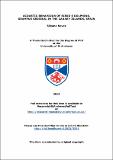Files in this item
Acoustic behaviour of Risso's dolphins, Grampus griseus, in the Canary Islands, Spain
Item metadata
| dc.contributor.advisor | Janik, Vincent | |
| dc.contributor.author | Neves, Silvana | |
| dc.coverage.spatial | xiii, 162 | en_US |
| dc.date.accessioned | 2013-06-03T13:21:03Z | |
| dc.date.available | 2013-06-03T13:21:03Z | |
| dc.date.issued | 2013 | |
| dc.identifier | uk.bl.ethos.574809 | |
| dc.identifier.uri | https://hdl.handle.net/10023/3591 | |
| dc.description.abstract | The Risso's dolphin (Grampus griseus) is a poorly studied species, particularly with respect to its acoustic behaviour. The little we know about Risso's dolphin acoustics shows that they are an interesting case study given that they combine acoustic features that place them inbetween very different delphinids. I investigated the acoustic repertoire of the species showing that Risso's dolphins produce mainly whistles, burst-pulses and click trains. I discussed the possible functions of each type of vocalization by contextualizing them into group behavioural patterns, size and habitat features. Although capable of whistling, Risso's dolphins seem to favour burst-pulses to communicate and maintain group cohesion following deep dives. Click trains were compared based on their inter-click interval patterns. Those were placed in their behavioural context and used to determine the number of animals echolocating at any given time. Risso's dolphins use a variety of inter-click intervals in each context. My data suggests that they may avoid predators by eavesdropping on the echoes of conspecific clicks while slow travelling and resting. Using 3D acoustic localization, I studied the biosonar performance and on-axis click characteristics of Risso's dolphin clicks. On one hand, Risso's dolphins do not seem to display range locking behaviour which makes them similar to beaked whales; on the other hand, they seem to apply automatic control to the transmitting side of their biosonar, which is similar to other delphinids such as the bottlenose dolphin. I also compared the whistle repertoire from Gran Canaria to that of another four locations. A discriminant function analysis using fundamental frequency parameters showed geographical distinction, most likely due to divergence caused by geographic isolation. To conclude, the Risso's dolphin is an interesting species that combines acoustic features from different cetacean species. This could suggest that Grampus griseus may be misplaced within the Delphininae sub-family. | en_US |
| dc.language.iso | en | en_US |
| dc.publisher | University of St Andrews | |
| dc.subject.lcc | QL737.C432N4 | |
| dc.subject.lcsh | Risso's dolphin--Canary Islands--Vocalization | en_US |
| dc.subject.lcsh | Risso's dolphin--Canary Islands--Behavior | en_US |
| dc.subject.lcsh | Dolphin sounds | en_US |
| dc.title | Acoustic behaviour of Risso's dolphins, Grampus griseus, in the Canary Islands, Spain | en_US |
| dc.type | Thesis | en_US |
| dc.contributor.sponsor | Fundação para a Ciência e Tecnologia (Portugal) | en_US |
| dc.type.qualificationlevel | Doctoral | en_US |
| dc.type.qualificationname | PhD Doctor of Philosophy | en_US |
| dc.publisher.institution | The University of St Andrews | en_US |
This item appears in the following Collection(s)
Items in the St Andrews Research Repository are protected by copyright, with all rights reserved, unless otherwise indicated.

